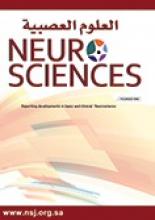Abstract
OBJECTIVE: To assess the proportion of eclampsia among patients admitted to the critical care unit (CCU) with an acute neurological emergency in the peripartum period, and careful clinical, laboratory, and radiological evaluation of non-eclampsia cases responsible for such presentation.
METHODS: A case series study that included women with acute deterioration of consciousness, with or without convulsions or neurological deficits, during pregnancy or puerperium, received in the CCU of Ibn Sina Teaching Hospital in Mosul, Iraq, from September 1st 2005 to August 31st 2006. A total of 30 women were included. They received careful clinical, radiological, and laboratory evaluation in an attempt to identify the cause of their presentation.
RESULTS: Eclampsia was found to be responsible for two thirds of cases (20 patients). The remaining one third was diagnosed as cerebral venous thrombosis (CVT) (7 patients), peripartum cerebral infarction (one patient), intracerebral hemorrhage (one patient), and acute fatty liver of pregnancy (one patient). Four of the women with CVT had preeclampsia during pregnancy. Imaging studies, particularly MRI and MR venography, provided the final diagnosis in most cases. Eclampsia was found more common in women presenting during their first pregnancy, while CVT was more common in multiparous women (p=0.0001). Cortical blindness was significantly associated with eclampsia instead of CVT (p=0.01).
CONCLUSION: Acute neurological symptoms in the peripartum period represent a diverse group of conditions, requiring careful clinical evaluation and early access to imaging studies.
- Copyright: © Neurosciences
Neurosciences is an Open Access journal and articles published are distributed under the terms of the Creative Commons Attribution-NonCommercial License (CC BY-NC). Readers may copy, distribute, and display the work for non-commercial purposes with the proper citation of the original work.






